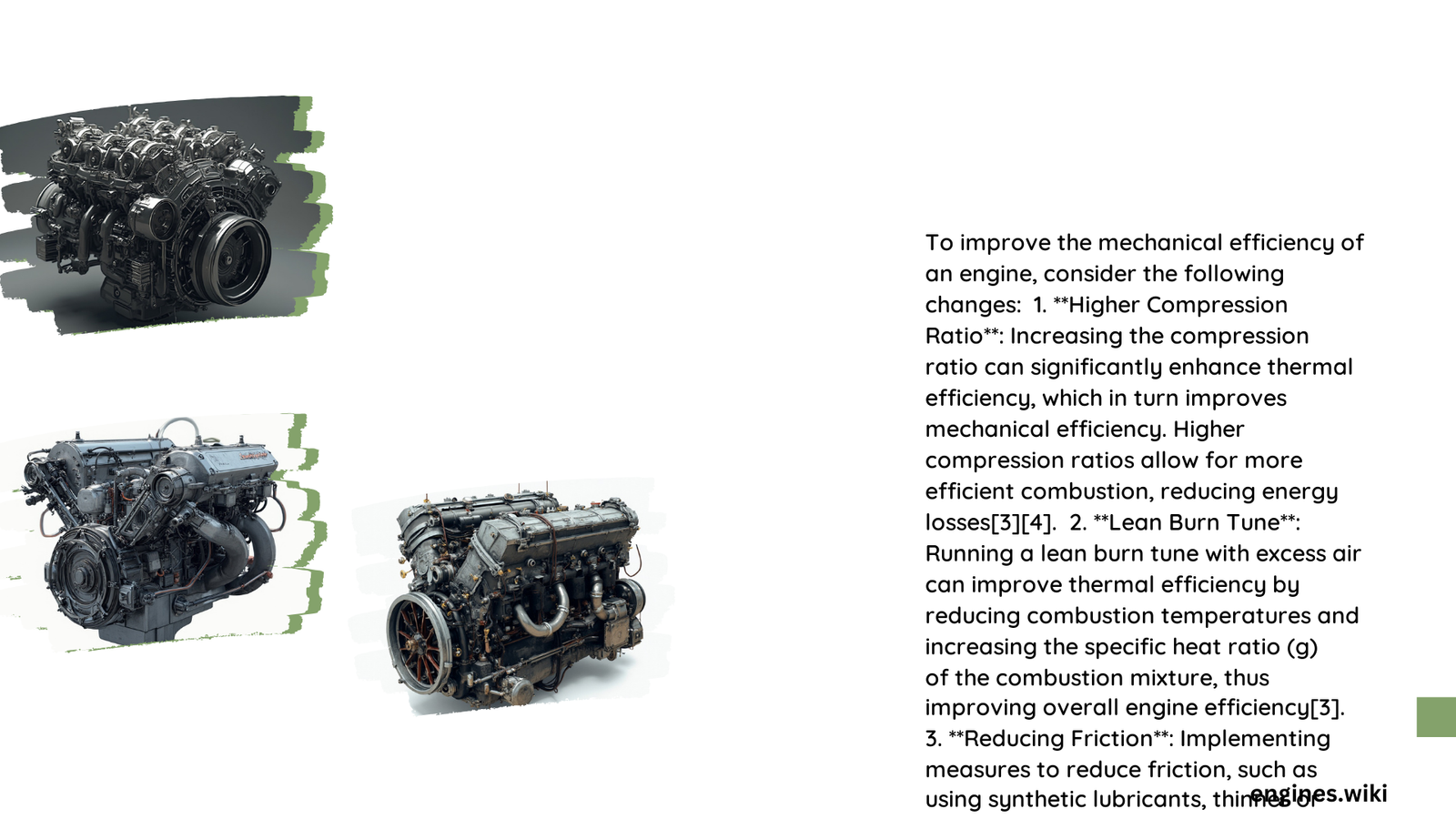Improving the mechanical efficiency of an engine involves various modifications that can enhance power output, fuel economy, and overall performance. These changes range from simple adjustments to complex overhauls, each with its own impact on horsepower and torque. This article explores the most effective modifications to boost engine efficiency, their quantitative effects, and the associated costs and challenges.
What is Mechanical Efficiency in Engines?
Mechanical efficiency in engines refers to the ratio of useful work output to the total energy input. It’s a measure of how effectively an engine converts fuel energy into mechanical power. Higher mechanical efficiency means more power output for the same amount of fuel input, resulting in better performance and fuel economy.
Which Modifications Can Significantly Boost Engine Efficiency?

1. Engine Tuning: How Much Can It Improve Performance?
Engine tuning, particularly through ECU remapping, is one of the most effective ways to enhance both horsepower and torque.
- Quantitative Impact:
- Horsepower increase: 10-20%
- Torque increase: 10-20%
-
Example: A 400 HP engine could potentially reach 480 HP after tuning
-
Techniques:
- ECU reprogramming
- Optimizing fuel injection parameters
- Adjusting ignition timing
-
Fine-tuning boost pressure (for turbocharged engines)
-
Costs: $500 – $5,000, depending on complexity and professional services
2. Fuel Injection Optimization: What Parameters Matter Most?
Optimizing fuel injection is crucial for enhancing combustion efficiency and overall engine performance.
Key Parameters:
1. Fuel Pressure
2. Injection Timing
3. Fuel Mixture Ratio
Optimal Settings:
– Fuel Pressure: Increase from 40 PSI to 60 PSI can improve torque by 5-10%
– Injection Timing: Slightly richer mixture at peak torque, leaner at peak horsepower
– Fuel Mixture Ratio: Varies based on engine load and RPM
Quantitative Impact:
– Torque increase: 5-15%
– Horsepower increase: 5-10%
3. Compression Ratio Adjustment: How Does It Affect Efficiency?
Adjusting the compression ratio can significantly impact thermal efficiency and overall engine performance.
Recommended Compression Ratios:
| Engine Type | Ideal Compression Ratio |
|---|---|
| Naturally Aspirated | 10:1 to 11:1 |
| Turbocharged/Supercharged | 8:1 to 9:1 |
| High-Performance | 11:1 to 12:1 |
Quantitative Impact:
– Increasing compression ratio from 9:1 to 11:1 can boost thermal efficiency by 5-7%
– Corresponding increase in horsepower and torque
Considerations:
– Higher compression ratios require higher octane fuel to prevent engine knock
– Significant mechanical modifications needed, increasing cost and complexity
4. Exhaust System Modification: What Changes Yield the Best Results?
Modifying the exhaust system can reduce back pressure and improve flow rate, leading to better engine efficiency.
Key Modifications:
1. Increasing pipe diameter
2. Using high-flow materials
3. Optimizing exhaust manifold design
Specifications:
– Pipe Diameter: Increasing from 2.5-inch to 3-inch can reduce back pressure by 10-15%
– Materials: Stainless steel or titanium for improved flow and durability
Quantitative Impact:
– Horsepower increase: 5-10%
– Torque increase: 3-5%
What Are the Challenges and Costs Associated with These Modifications?
Each modification comes with its own set of challenges and costs:
- Engine Tuning:
- Challenges: Requires specialized knowledge and tools
- Risk: Incorrect tuning can lead to engine damage
-
Cost: $500 – $5,000
-
Fuel Injection Optimization:
- Challenges: Precise adjustments needed, sensitive to other engine parameters
-
Cost: $500 – $2,000 for standalone systems (often included in ECU tuning)
-
Compression Ratio Adjustment:
- Challenges: Significant mechanical modifications required
-
Cost: $2,000 – $10,000
-
Exhaust System Modification:
- Challenges: Requires careful design to avoid negative impacts
- Cost: $500 – $3,000
Conclusion: Which Change Offers the Best Balance of Efficiency and Cost?
While all these modifications can improve engine efficiency, engine tuning through ECU remapping often provides the best balance of performance gains and cost-effectiveness. It can yield significant improvements in both horsepower and torque without requiring extensive mechanical modifications. However, the best approach may vary depending on the specific engine, budget, and performance goals.
For those seeking maximum efficiency gains, a combination of these modifications, starting with ECU tuning and progressing to more complex changes like compression ratio adjustment, can yield the most substantial improvements in mechanical efficiency.
Remember, any modification should be carefully considered and ideally performed by professionals to ensure optimal results and prevent potential damage to the engine.
